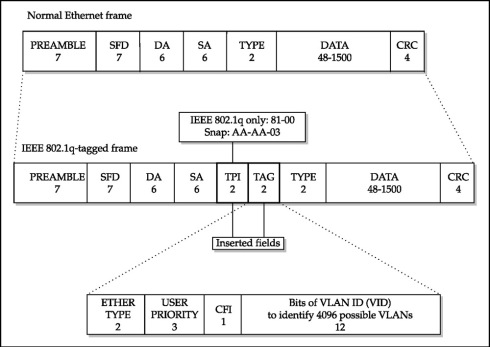
TPI:
—–
* Two bytes Tag protocol identifier (TPI) identify the Ethernet frame as an 802.1Q frame. Value equal to 0x8100.
These bytes never change. When an Ethernet switch sees these bytes, it knows that the frame is an 802.1Q frame.
* This field is located at the same position as the EtherType/length field in untagged frames, and is thus
used to distinguish the frame from untagged frames.
TAG Control Information (TCI):
—————————–
-> The second two bytes, or 16 bits if you prefer, are carved into three fields
I). User priority: 3 bit, used to identify a priority level for this packet.
* 0 – Best Effort (Lowest priority)
* 1 – Background
* 2 – Reserved
* 3 – Effort
* 4 – Load
* 5 – Video
* 6 – Voice
* 7 – Network (Highest priority)
II). Canonical Format Indicator (CFI):
* The standard notation (called canonical format) for MAC addresses is written in transmission order with
the least significant bit of each byte transmitted first.
Eg: 0x12 = 0001 0010 (Least most bit first, far right), will be transmitted as 01001000. (Eg: Ethernet Type).
* In non canonical format, most significant bit of each byte transmitted first.
Eg: 0x12 = 0001 0010 , will be transmitted as 0001 0010. (Eg: Token ring Type).
* 1 bit, indicates whether bit order is canonical (set to 0) or non-canonical (set to 1)
* It is always set to zero for Ethernet switches.
* CFI is used for compatibility reason between Ethernet type network and Token Ring type network.
– Token Ring Type : It sends the bytes over the wire with the most significant bit first.
– Ethernet: It sends the bytes(octets) over the wire, left-to-right, with least significant bit in each byte first.
* If a frame received at an Ethernet port has a CFI set to 1, then that frame should not be forwarded as it is to an untagged port.
III). VLAN ID:
* 12 bit, so 0 to 4095.
* It specifying the VLAN to which the frame belongs.
* VID of 0(0x000) is used to identify priority frames and value 4095 (0xFFF) is reserved,
so the maximum possible VLAN configurations are 4,094.